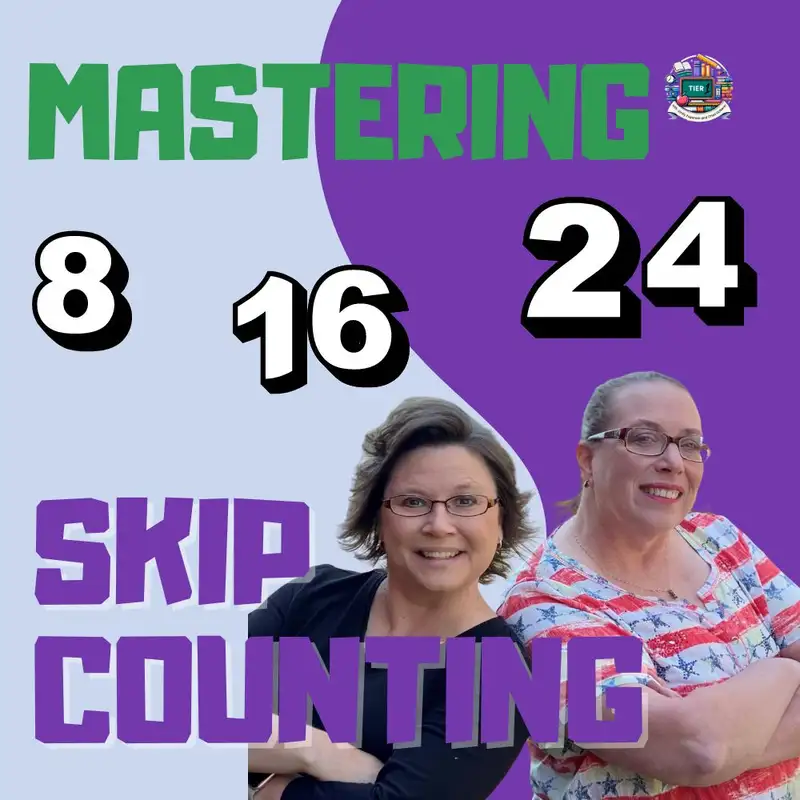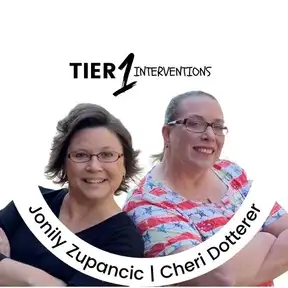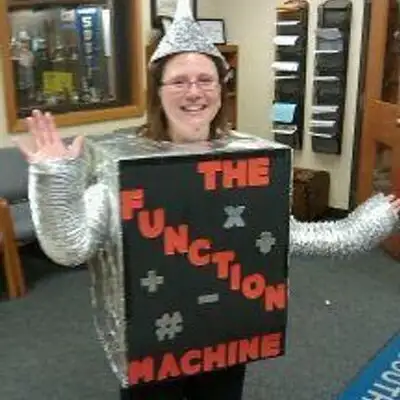
Teaching the 120chart to 6th grade students: T1I S1 E12
Cheri Dotterer: Good morning.
Welcome to tier one
interventions with jonily
Zupancic and Cheri dotterer.
Jonily : Hey, jonily Zupancic
here, Jay Z in the house today,
and tier one interventions is
really about strengthening our
core in schools. If you think
about your body, our overall
health really depends on our
core and our core strength in
schools, our core is our tier
one, general classroom, general
ed teacher with intervention
specialist or other support
personnel in the classroom and
inclusive model serving all kids
at the same time. So tier one
interventions is about the
instructional strategies that
are going to enhance and
maximize the learning for all
students, regardless of ability
or disability, tier one needs to
be strong enough to make certain
that all ability levels of
students get their needs met.
And I know this can seem really
overwhelming for the general
classroom teacher, however, tier
one interventions is all about,
what are those techniques? Those
techniques have to do with the
student body, brain and emotion,
and how do we get all three of
those things ready to learn the
content we get this question all
the time. Are your strategies
research based? That's a big
topic. How do I know that this
is going to work? What's it
grounded in? And my answer to
that is absolutely yes.
Everything we're teaching for
this core, general classroom is
research based. Now we have to
define what research based
means, and then I've just given
you all of the examples of it.
Research based is the work that
we do. Is it grounded in the
Mighty Hands of giants that have
come before us? And what that
means is the research and the
work that others have done. How
has that then impacted or
affected the parallels and the
strategies that we teach
research based is about looking
at these influences. I mentioned
one other book, make it stick.
Make It Stick. Make It Stick is
a number of researched
strategies for cognitive
science, and all of the
strategies that Sherry and I are
teaching are supported through
the strategies that at the
university level are taught in
the book make it stick, and in
other places, about how to
trigger and stimulate good, just
right, cognitive demand. 120
chart is mathematical tier one
intervention strategy. Even
though it's the second one we're
talking about, I would say that
it's the most powerful and most
important. What are we trying to
do in the core classroom for
mathematics? The ultimate goal
is to improve student number
sense. Number Sense is the
innate, intuitive understanding
of number number sense cannot be
taught. It can only, only be
learned and experienced. Our
instructional techniques are
absolutely essential when we're
trying to improve a student's
number sense, because I cannot
explicitly teach this. I can
only engage them in repetitive
good the 120 chart connects to
dozens and dozens of standards
from kindergarten through high
school. And what we're going to
share with you today is all of
the standards and targets that
the 120 chart can expose for our
students. The 120 chart is a
chart that has 120 numbers on
it. It's as simple as that we're
going to walk through each of
the interactions that we take
students through with this chart
I'm going to share with you
interaction one, which is just
introducing the 120 chart to our
students. And when I say
interactions, we know that our
strongest math students, that
may even be identified as
gifted, May. Need one or two
interactions with something
before forever learning happens.
They're going to know it
forever. Bright students who are
not gifted, there is a distinct
difference between gifted
students and bright students.
Gifted students love learning,
don't like school. Bright
students love school, don't
necessarily like learning.
They're almost polar opposites.
Bright students oftentimes
appear to achieve higher because
they work harder. They are
teacher pleasers. They want to
do well. Gifted students don't
have a care about any of that.
However, gifted students have
this stronger, innate, intuitive
sense of numbers. How do I know
this? Because for a number of
years I studied my gifted
students, I do not think like
gifted students think in
mathematics. I studied my gift
and gifted students and tried to
extract the way that they
thought about mathematics and
most of the techniques and tasks
that I share with teachers
today, I learned from my gifted
kids, they have a really savvy
sense of number, but bright
students might need five to
seven interactions with the same
thing before they have this
forever learning. Bright
students will give themselves
the their own interactions,
because they tend to work above
and beyond. So they get more
interactions, regardless of
whether those are provided in
the classroom. I'm going to skip
all the way to our struggling
students, maybe students with
learning disabilities or lower
cognitive abilities, or students
that have some kind of brain
disconnect, or students with
ADHD, or any of those students
that struggle in the regular
general classroom, they may need
60 to 100 interactions with the
same thing before they truly
learn it. 66, zero, 60 to 100
sometimes 200 or 300 and this is
where tier one mathematics, the
general classroom, falls short.
The way that we typically teach
mathematics in the general
classroom is we teach one topic
at a time, and all the
repetition is done in a
condensed two or three week
cycle, whereas in the model that
we're presenting to you, we
identify the essential
mathematics that we're going to
do through the 120 chart, and
once we identify the essential
mathematics, those topics are
cycled in every single month. I
call this interaction one
because this is the first
interaction at the beginning of
the school year that kids
experience 120 chart. And then
throughout the school year, 120
chart is brought back up maybe
once a week, once a month, three
times a year, and then every
year after that, if your school
and district really create this
progressive, consistent
approach, the way that we get
more interactions over time for
kids is we focus on the same
task. Today's example is 120
chart, very powerful, and we
allow students to interact with
this task multiple times
throughout the year and every
year from preschool through high
school. So the first thing that
I will do when I introduce 120
chart, and here's a visual of
it, 120 chart, it's 10 numbers
in each row. So we have 12 rows,
120 numbers, and I'll ask
students and prompt them with my
favorite three words, tell me
about the 120 chart. This allows
me to do exactly what I was
talking about before, which is,
gain students perspective. Let
them know they belong. Let them
have an opportunity to process
and think and shift their
cognitive demand naturally to
their just right spot. And then
I will ask students to share.
What do you notice about the 120
chart?
Cheri Dotterer: Now, Hey,
everybody, sit back and listen
to the hear me teach segment of
the 120 chart?
Jonily : All right, excellent.
We are grade six, and we are
going to come back to 120 chart.
There are many math discoveries
that can be made from the 120
chart. We have explored this a
number of times, but we're going
to go deep today. Let's first
recall, retrieve. Raise your
hand to tell me what discoveries
can be made with the 120 chart,
what mathematical phenomenon can
be unpacked. Tell. Me about the
120 chart. Start us off. Emma,
oh my gosh, perfect. Yep,
perfect. Lauren, you can find
anything. Do you multiply? The
one that we do most is finding
out if eight, if you want to
multiply the eight. What do we
have? Though, fantastic, yeah,
because I get real cranky about
eight. Real cranky about eight.
And we'll talk about why in just
a moment. What else can you tell
me about our experiences with
120 chart. What else can you
tell me about our experiences
with 120 gonna try, yeah.
Kendall, I
Unknown: was gonna say, I was
gonna say that, if it's not a
number, what number could get
to? Oh, love
Jonily : it so much. Fifth
grade, stay quiet, because we're
doing math here. Sixth grade.
Kendall, you said something
really great. Say it again. Is
Unknown: it not a whole number?
What number would be like? What
would not be a whole number? A
whole number that would get
Jonily : so we have to then, and
that's really the gist of 120 is
skip counting, and then the goal
is to land on 100 but what
Kendall is saying, she said it
really nicely. What if it
doesn't land on 100 then we have
to talk about parts of skip
counts. Now there's a reason I
get cranky about eight what I'm
going to do is I'm going to give
you this chart get cranky about
and the first thing I want you
to do is turn to the back of
this chart and I'm going to tell
you the something I want you to
write on the back of this chart.
Now don't say this out loud, but
on the back of this chart, I
want you to write down the
decimal number for one. Don't
say this out loud, but on the
back of this chart, I want you
to write down the decimal number
for one. Don't say this out
loud, but on the 1/8 on the back
of your chart, I don't want to
know what your neighbor knows on
the back of your chart, I want
you to write down the decimal
number that is equivalent to 1/8
on the back of your chart. You
know, write down the decimal
number not what your neighbor
thinks the decimal number that
is equivalent to 1/8 you know,
write down the decimal number,
not what you're now if you wrote
a decimal that has an eight in
it, that is not correct. And
this is why I get cranky with
eight when we're looking at
fractions, and this is why I get
crazy. Every fraction has a
decimal number and a percent
number that is equivalent. And
1/8 is not 8% and it's not 80%
and it's not 18% it's nothing
with an eight in it. This is
where the 120 chart comes in. So
go to the front of your chart.
Go to the front of your chart.
The denominator of our fraction
tells us exactly what you were
telling me about. It is our skip
counting number. So circle the
numbers that when you skip count
by eight you land on. You should
be really good at this by now,
because we've done this with
eights a lot. So go ahead and
circle the numbers when you skip
count by eights. And here's
another thing, that if you're
doing this at this point, you
are not only glitched, but you
really have huge math deficits.
You are not circling 818, 2838
if you did that, you are way
off. So you're skipped counting
by eight. So that would be
eight, and then what 1624, and
32 good. Go ahead and stop. Just
do those on your own. And we're
trying to answer two questions.
Number one, how many counts? By
eight to land on 100 and we're
going to have to go with what
Kendall said. We're going to
have to go with what Kendall
said, and that is, we might have
parts of a count. The second
question is, do. How much money
is 1/8 of $1 because that's
going to tell us the exact
decimal equivalent. So to back
up, if you need a refresher, to
back up, if we want to refresh
all this, we're on our 120
chart. We're skip counting by
what number eight? So circle the
numbers when you skip count by
eight. So you circle eight and
then 1624, 32 and keep going.
Does eight land on 100 No, so
we're going to have to use
Kendall strategy. We're going to
need part of a number. So what
number does eight land on 96 and
yeah 104 You're right. How many
skip counts by eight lands on
9612 and then 104 is 13. So it's
somewhere between 12 and 13.
Good. 100 is exactly halfway.
Yes, if I say how many skip
counts? Does it take? That is 12
and a half. But how much money
is an eighth of $1 how many
cents? 12.5 cents? But where
does the decimal go? If I want
to show 12 cents. Caleb, $0 and
how much? How do I show 12 cents
to the decimal go if I want to
show 12 cents, Caleb, point
decimal, 12. How much money is
that? 0.12? How much money? 12
cents, and we could put a half,
or what decimal number means a
half? Tell me five. So the
decimal equivalent for 1/8 is
0.125 and that is the exact
number of skip counts that land
on 100 that's the exact number
of skip. Now we've done the 120
chart how
Cheri Dotterer: generally goes
on and teaches for another 15 or
20 minutes or so. If you are
interested in hearing the rest
of that conversation, we
recommend that you join tier one
interventions workshop. That is
a workshop that we host live
once a month with the next
episode will be in September. So
if you're hearing re listening
to this after September of 2024
you will have to go back and
listen to that episode later.
However, we are recording them.
We are putting them in a portal.
You will be able to listen to
the full episodes inside the
course platform. So if you are
interested in learning more
about the hear me teach
segments. We have multiple
versions inside the course, we
look forward to hearing from you
and and hope that these episodes
are helping you understand some
math concepts in a new way. This
has been cheri dotterer from
tier one interventions. Have a
blast of a summer. Thanks. You.
Episode Video
Creators and Guests


